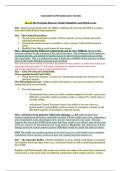Class notes
A Level Edexcel Cognitive Psychology Notes (with Essay Plans)
- Course
- Institution
Full notes on everything you need to know for Cognitive Psychology for Psychology Paper 1, Edexcel. Includes colour coded points for AO1, AO2, AO3 and full and complete essay plans!
[Show more]



